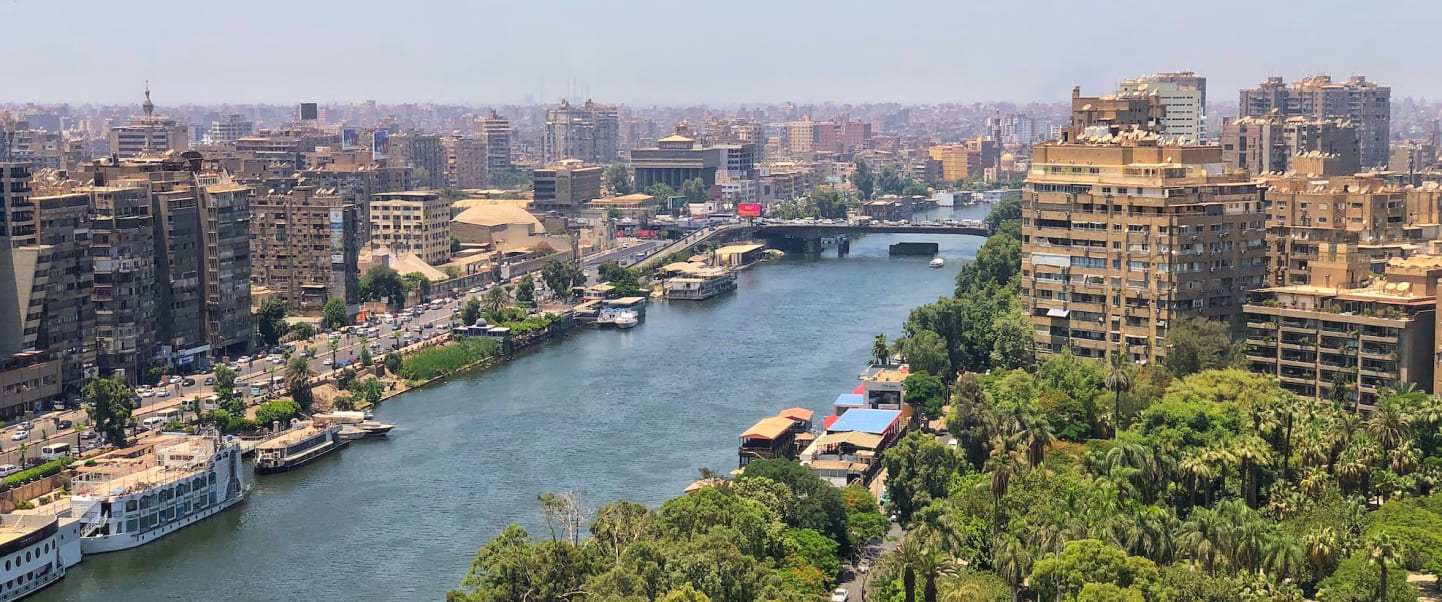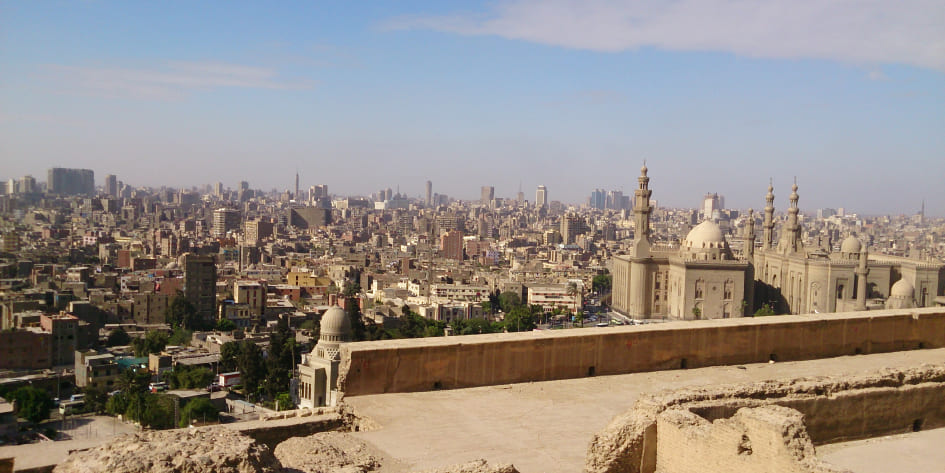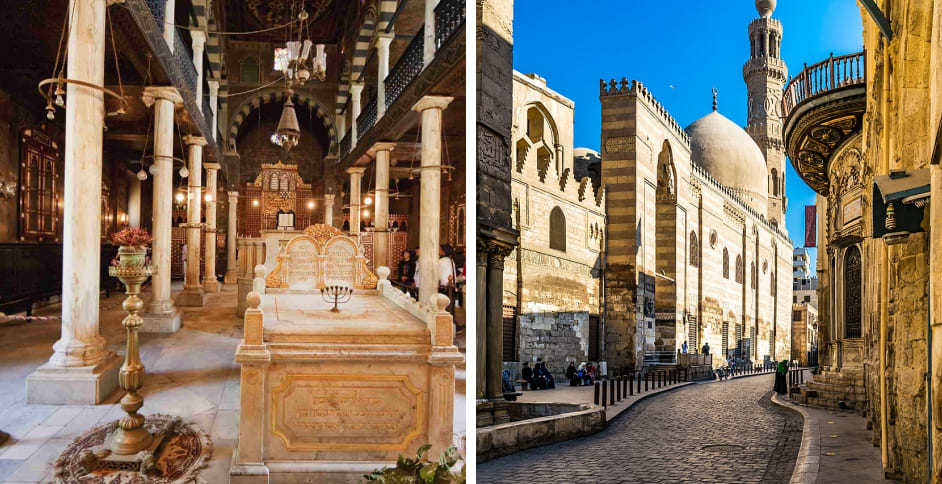


Let’s go for a walk in Old Cairo and learn more about the Coptic Hanging Church, some most famous mosques in the Islamic world, the City of the Dead or Cairo necropolis and much more.
The old part of the city is located in the east. The popularity of this area of Cairo among tourists is explained by its historical, cultural and religious diversity.
In the times of the Roman Empire, fort Babylon was built there. Over the years, the fortress housed the barracks and headquarters of the three legions that supported the Roman government in Egypt. The ruins of fortifications have been preserved to the present day, and a gatehouse of Babylon Fortress was used in the 3rd century AD as a foundation to build the Saint Virgin Mary’s Church. This Coptic Orthodox Church is also known as the Hanging Church for its location above the Roman fortress. The church houses about 100 icons, many of which were created by icon painters more than a thousand years ago.
The monastery and the Church of St. George which date back to the 10th century AD, are also located in Old Cairo. The monastery is also the official seat of the Greek Orthodox Patriarch of Alexandria. It is believed that one of the chapels of St. George’s Church was built on the site of the grotto where the Holy Family (the Virgin Mary, Joseph and Jesus Christ) hid during their flight to Egypt.

Within walking distance from the Christian places of worship there is the Ben Ezra Synagogue that dates back to the 4th century AD. The synagogue gained worldwide fame thanks to the repository of ancient Jewish and Aramaic manuscripts found there.
The Mosque of Amr ibn al-As which is the oldest mosque in Africa built in 642 after the Arab conquest of Egypt, adds to the cultural diversity of Old Cairo.
We can’t help but mention al-Muizz, one of the oldest streets in Cairo. According to the study carried out by the United Nations, the greatest concentration of medieval architectural treasures in the Islamic world is located there. This is, without exaggeration, the history of Cairo in miniatures!
Al-Muizz street features a wide variety of shops, stalls, kiosks and counters. Of course, in most of them common simple souvenirs, designed for unassuming tourists, are sold. However, there you can also find some valuable things made of silver, copper, and mother-of-pearl. There are also shops selling antiquarian things and old books. If you are interested in antique and rare things, you should drop by such shops. Firstly, there are many handmade things in Egypt. Secondly, it is not customary there to throw away things left after the older family members. Sometimes such objects are handed over to antique shops and flea markets, which means that it is quite possible to find gizmos of a certain value there. The heart of Old Cairo is Khan el-Khalili bazaar. It’s a large, busy and colorful open-air bazaar, one of the oldest ones in Cairo. It’s one of the most popular tourist attractions where spices, oils, papyruses, silk and jewelry are sold.

The foundation of this neighborhood coincided with the golden era in the history of Cairo, when the city was one of the largest and richest in the world. At that time, Egypt was ruled by the Ayyubid dynasty, established by Yusuf ibn Ayyub ibn Shadi commonly known as Salah ad-Din (Saladin), who led the Muslim military campaign against the Crusader states in the Levant.
The area of Islamic Cairo is proclaimed a World Cultural Heritage site by UNESCO and is considered to be the heart of the modern capital. Let’s highlight some truly unique medieval buildings among a great number of them.
One of the most important mosques in the Islamic world is located in the northwestern part of Islamic Cairo. It’s Al-Azhar Mosque which was built in the middle of the 10th century. The Al-Azhar University associated with the mosque, is one of the oldest in the world. It has been a center of Arabic literature and Islamic learning in the world for centuries.
The Citadel of Cairo is a medieval Islamic-era fortification in Cairo, built by Salah ad-Din (Saladin) and further developed by subsequent Egyptian rulers. The citadel bastions enjoy a fascinating view of the medieval districts and the two largest mosques in the city – the Mosque-Madrasa of Sultan Hassan and the Al-Rifa’i Mosque. Together they make a single architectural ensemble, and tourists can hardly imagine that they were built with a long gap between the dates of their construction. Thus, the Mosque-Madrasa of Sultan Hassan was built in 1363, while the Al-Rifa’i Mosque was constructed… 600 years later! Inside the Citadel of Cairo, in the Southern Enclosure there’s the Great Mosque of Muhammad Ali Pasha, who is considered to be the modernizer of Islamic Egypt. The mosque was built in the first half of the 19th century by Yusuf Boshnak from Istanbul and its model was the Sultan Ahmed Mosque in that city. Unfortunately, the earthquake of 1992 caused significant destruction in Islamic Cairo. Nevertheless, due to it many buildings that had been in oblivion for decades, were gradually restored to their former splendor. However, many monuments of Islamic Cairo are currently still closed to the public.

Cairo Necropolis is separated roughly into two regions: the Northern Cemetery to the north of the Citadel of Cairo and the older Southern Cemetery to the south of the Citadel. It’s a series of vast Islamic-era necropolises and cemeteries, covering an area roughly 6 km long. The necropolis has been developed over many centuries and contains both the graves of Cairo’s common population as well as the elaborate mausoleums of many of its historical rulers and elites, who ruled the country between the 7th and 19th centuries. Some of the tombs are masterpieces of Islamic architecture. The sights of the City of the Dead should be visited as part of a guided tour, not going there on your own, because this area has a dark side.
Over the past 70 years, Cairo has seen an unprecedented influx of migrants from rural areas who relocate, hoping to find a job and have a better life. Sometimes difficulties with earning a livelihood make people settle in abandoned crypts not to live in the streets. As a result, the Cairo necropolis has evolved into slums. Now about half a million people live in Al-Qarafa, including outcasts and criminals, that’s why foreign tourists aren’t recommended to visit this place unaccompanied.
